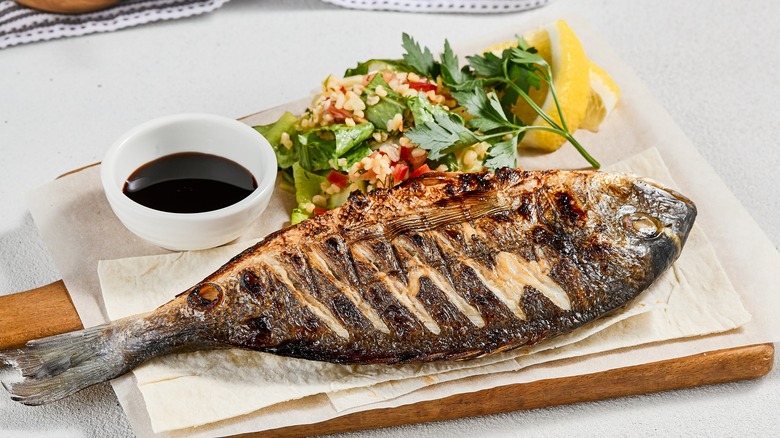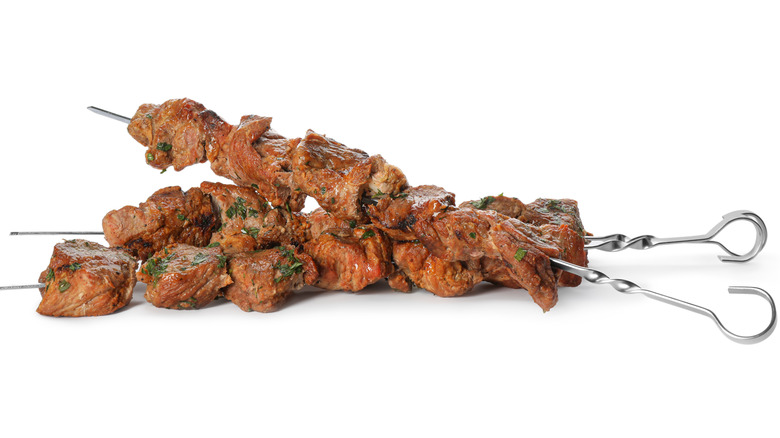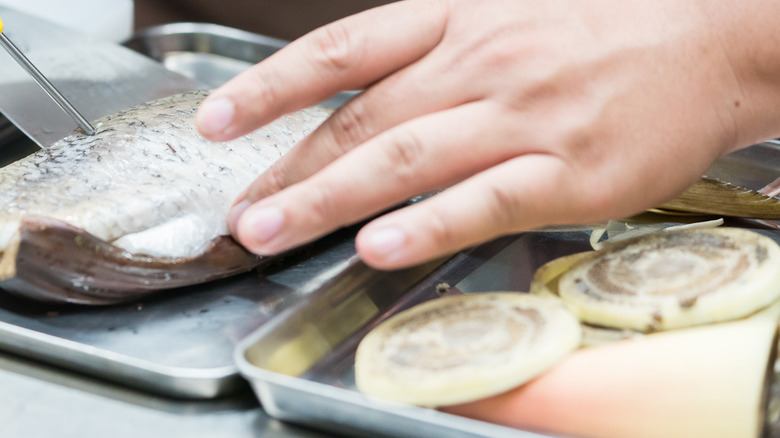The Simple Skewer Trick To Tell If Fish Is Done Cooking
It's important for fish to be properly cooked — not just for the best eating experience, but for food safety reasons, too. Simply put, overcooked fish is dry and disappointing. Seafood Nutrition Partnership insinuates that many species are potentially ruined by lingering too long in the pan. Lean, flaky fish like bass, flounder, mahi-mahi, and trout are better suited for wet cooking methods, while heartier tuna, cod, halibut, and swordfish can withstand dry, high-heat techniques, says MasterClass. Undercooked fish comes with the risk of food poisoning, including parasitic and bacterial infections, like salmonella, per CNN (via Center for Disease Control).
Seafood Nutrition Partnership additionally states that you want to ideally cook your fish to 140-145 degrees Fahrenheit on the inside — following the 10-minutes-per-side rule, and flipping the fish halfway through cooking. But how will you know for sure if it's done? Perhaps your heat hasn't been consistent. Maybe, like so many of us, you were distracted while cooking, or you misplaced (or don't own) a meat thermometer. Have no fear, you can test the doneness of fish — and much more — with a basic metal skewer. Here's how.
Stick it in and check it out
To start, search your kitchen drawers for a metal barbecue skewer — the kind that evokes summertime grilling. Per Today, insert the skewer into the thickest part of the fish's flesh, remove it, and touch it against your hand. If it's just hot, the fish is done, and if it's cool, it's not. Better Homes and Gardens's test kitchen adds that cooked fish will be dull and opaque, with firm meat that flakes away at the gentle twist of a fork. Soft, non-flaking, and translucent flesh are all signs that your fish needs more time — just don't overdo it, BHG warns.
In the absence of a skewer, a cake tester, the tip of a knife, or similar metal tool can be used to test the doneness of your fish, Lacademie says. This phenomenon works due to heat conduction or thermal conductivity, which measures how fast a material transfers heat from hot places to cool places, according to Industrial Metal Supply. This helps explain why metals are popular choices for cookware. They add that stainless steel is relatively low on the conductivity end, with carbon steel and iron higher on the spectrum. But your skewer should work just fine for your fish dinner.
Other uses for skewers
Aside from fish-testing, there are other practical uses for skewers in the kitchen. While in the United States it's commonplace to call anything cooked on a skewer a "kabob," Independent explains that kebabs come from the Middle East and the term "shish kebab" may have come from Turkish soldiers in the field impaling their food with swords (shish) and roasting it over the fire. Independent adds that Japanese yakitori and Nigerian suya are other popular forms of meat on a stick, and, of course, who can forget camping trip hotdogs and the sweet skewered treat known as s'mores?
Metal skewers are useful because they're hard to break, washable, and can be used to make many meals, adds Independent. Though it's important to note that they're not recommended for appetizers because of the same heat conduction that makes them great for testing fish doneness. Instead, they recommend broad, flattened skewers with good handles for ease of use. With those in hand, take on grill master Bobby Flay's garlic-mustard grilled beef skewers, Yucatan chicken skewers, or salmon kebabs with yogurt sauce. Ree Drummond enters the fray with "Big Bad Beef Skewers," and Alton Brown, experimental as always, throws a delicious culinary curveball with vanilla lime pineapple skewers. And to think that these metal sticks would collect dust until your next cookout! Now you know that the skewer is far more than a noun and a verb — it's a handy cooking tool to have around.


